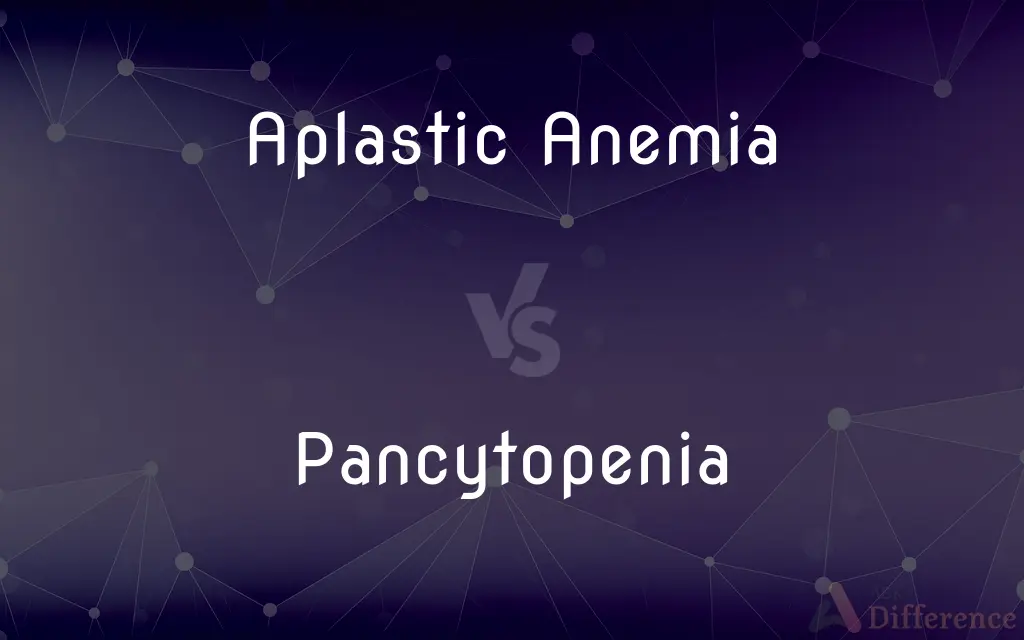Aplastic Anemia vs. Pancytopenia — What's the Difference?
By Tayyaba Rehman & Fiza Rafique — Published on February 2, 2024
Aplastic Anemia is a bone marrow failure disorder leading to reduced blood cell production. Pancytopenia is a condition with decreased counts of all blood cell types.

Difference Between Aplastic Anemia and Pancytopenia
Table of Contents
ADVERTISEMENT
Key Differences
Aplastic Anemia is a serious condition where the bone marrow fails to produce adequate amounts of blood cells, leading to a deficiency in red cells, white cells, and platelets. Pancytopenia, on the other hand, refers to the reduction of all types of blood cells in the circulation, which can result from various causes including bone marrow disorders like Aplastic Anemia.
While Aplastic Anemia specifically indicates a problem with the bone marrow's ability to produce blood cells, Pancytopenia is a broader term that can result from conditions affecting the bone marrow or from peripheral destruction of blood cells.
Aplastic Anemia can lead to Pancytopenia as one of its manifestations, but Pancytopenia can also occur independently of Aplastic Anemia due to other medical conditions.
Understanding the distinction is crucial for diagnosis and treatment, as Aplastic Anemia's management focuses on stimulating or replacing bone marrow function, whereas Pancytopenia's treatment depends on its underlying cause.
Comparison Chart
Definition
Bone marrow failure leading to reduced blood cell production
Decrease in all blood cell types (red, white, platelets)
ADVERTISEMENT
Primary Cause
Damage to bone marrow stem cells
Various, including bone marrow failure, increased destruction, or distribution issues
Manifestation
Can manifest as Pancytopenia among other symptoms
Not a disease itself, but a symptom of underlying conditions
Treatment Focus
Restoring bone marrow function
Addressing the underlying cause
Associated Conditions
Often idiopathic, can be caused by toxins, radiation, or autoimmune diseases
Can be due to bone marrow disorders, infections, cancers, or drug reactions
Compare with Definitions
Aplastic Anemia
Often treated with immunosuppressive therapy or bone marrow transplantation.
Immunosuppressive therapy has shown promise in treating Aplastic Anemia cases.
Pancytopenia
Can be a manifestation of various underlying conditions, including severe infections or bone marrow disorders.
Her Pancytopenia was ultimately traced back to a severe autoimmune disorder.
Aplastic Anemia
Diagnosis involves bone marrow biopsy to evaluate cell production.
The bone marrow biopsy confirmed the diagnosis of Aplastic Anemia.
Pancytopenia
Requires a comprehensive evaluation to determine the cause, including bone marrow examination.
To understand the cause of his Pancytopenia, he underwent an extensive medical evaluation.
Aplastic Anemia
Can be acquired or congenital, with varying degrees of severity.
Congenital Aplastic Anemia is rare but requires early intervention.
Pancytopenia
Treatment is often directed at the underlying cause, rather than the Pancytopenia itself.
Treating her leukemia effectively resolved the Pancytopenia.
Aplastic Anemia
Can lead to severe fatigue, infections, and bleeding due to lack of blood cells.
His Aplastic Anemia made him extremely prone to bruising and infections.
Pancytopenia
A hematological condition characterized by the reduction of red and white blood cells and platelets.
The lab tests revealed Pancytopenia, indicating a severe drop in his blood cell counts.
Aplastic Anemia
A condition where the bone marrow fails to produce sufficient blood cells.
After being diagnosed with Aplastic Anemia, she underwent a bone marrow transplant.
Pancytopenia
Can lead to symptoms like fatigue, bleeding, and increased susceptibility to infections.
The symptoms of his Pancytopenia included unexplained bruises and frequent infections.
Pancytopenia
An abnormally low level of red blood cells, white blood cells, and platelets in the circulating blood.
Pancytopenia
(pathology) A reduction in the numbers of red blood cells, white blood cells and platelets in the blood
Pancytopenia
An abnormal deficiency in all blood cells (red blood cells and white blood cells and platelets); usually associated with bone marrow tumor or with aplastic anemia
Common Curiosities
Can Aplastic Anemia cause Pancytopenia?
Yes, Aplastic Anemia can lead to Pancytopenia as it affects the production of all types of blood cells.
How does Pancytopenia differ from Aplastic Anemia?
Pancytopenia is the presence of reduced levels of all blood cell types in the blood, which can be a symptom of Aplastic Anemia or other conditions.
What are the common symptoms of Aplastic Anemia?
Symptoms may include fatigue, paleness, frequent infections, bleeding, and easy bruising.
What are the treatment options for Aplastic Anemia?
Treatments may include blood transfusions, immunosuppressive therapy, or bone marrow transplantation.
What are the common symptoms of Pancytopenia?
Symptoms may include weakness, fatigue, increased susceptibility to infections, and a higher risk of bleeding.
What are the treatment options for Pancytopenia?
Treatment depends on the underlying cause and may include addressing the underlying condition, blood transfusions, or medications to stimulate blood cell production.
Is Aplastic Anemia the same as Pancytopenia?
No, Aplastic Anemia is a specific disorder where the bone marrow fails to produce enough blood cells, while Pancytopenia is a broader term indicating low levels of all blood cell types.
How is Aplastic Anemia diagnosed?
Diagnosis involves blood tests, bone marrow aspiration, and sometimes genetic testing to confirm the condition.
What is Pancytopenia?
Pancytopenia is a condition characterized by low levels of all three major blood cell types: red blood cells, white blood cells, and platelets.
Can Pancytopenia be a symptom of Aplastic Anemia?
Yes, Aplastic Anemia is one of the potential causes of Pancytopenia, but there are other causes as well.
What is Aplastic Anemia?
Aplastic Anemia is a condition where the bone marrow does not produce enough new blood cells, leading to a shortage of all three types of blood cells.
Can lifestyle changes help manage Aplastic Anemia or Pancytopenia?
Lifestyle changes alone are not sufficient to manage these conditions; medical treatment is usually necessary to improve blood cell counts and overall health.
How is Pancytopenia diagnosed?
Diagnosis involves blood tests, bone marrow aspiration, and other tests to determine the underlying cause.
Are these conditions reversible?
Aplastic Anemia and Pancytopenia can be reversible if the underlying cause is identified and effectively treated.
Are there any long-term complications associated with these conditions?
Yes, if left untreated, both conditions can lead to severe complications, including life-threatening infections and bleeding.
Share Your Discovery

Previous Comparison
MUV vs. XUV
Next Comparison
Monocots vs. DicotsAuthor Spotlight
Written by
Tayyaba RehmanTayyaba Rehman is a distinguished writer, currently serving as a primary contributor to askdifference.com. As a researcher in semantics and etymology, Tayyaba's passion for the complexity of languages and their distinctions has found a perfect home on the platform. Tayyaba delves into the intricacies of language, distinguishing between commonly confused words and phrases, thereby providing clarity for readers worldwide.
Co-written by
Fiza RafiqueFiza Rafique is a skilled content writer at AskDifference.com, where she meticulously refines and enhances written pieces. Drawing from her vast editorial expertise, Fiza ensures clarity, accuracy, and precision in every article. Passionate about language, she continually seeks to elevate the quality of content for readers worldwide.













































